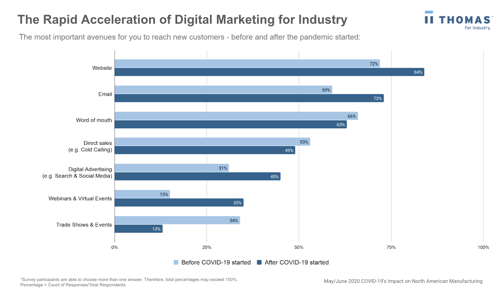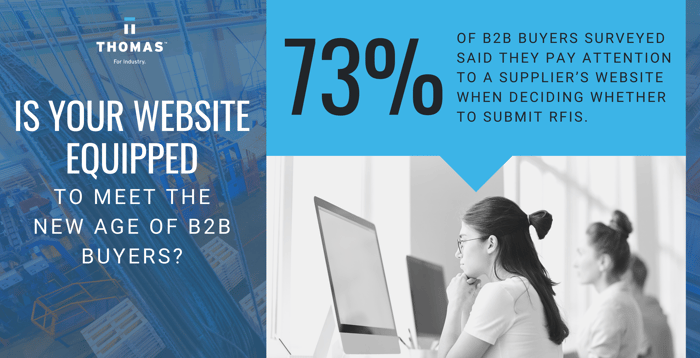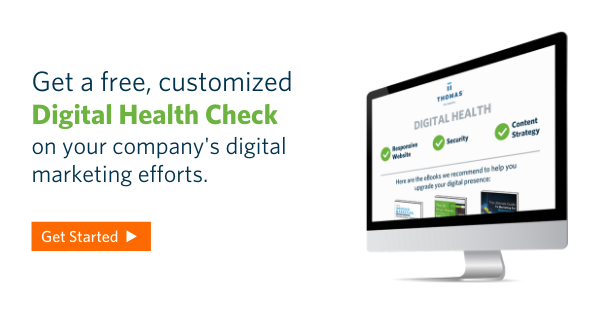The Ultimate Guide To A Manufacturing Marketing Strategy in 2022
Team Thomas February 15, 2022
Marketing isn't a new practice.
It has actually — if you can believe it — been around for centuries.
And while many manufacturing and industrial companies are successfully implementing aspects of marketing such as email campaigns, social media engagement, and a modern website, there's always room for improvement (or to get started if you haven't already).
A well executed strategy will have a place in each area of business, especially pricing, product, and sales, so it's important to do it right if you want to:
- Get more customers
- Acquire more high-quality leads
- Increase revenue
- Expand your business into new markets
Sound like a plan? Great!
In this blog, we’ll break down everything you need to know about starting and/or optimizing a strategy of your own — and we'll include additional marketing resources for deeper dives along the way.
Inbound Marketing Works For Manufacturers
The practice that we've seen have the most success — in our 124 years of working with industrial companies — is inbound marketing. It's not an industry buzzword or complicated practice but rather a coordinated effort to bring those procurement pros, engineers, and buyers directly to you.
One of our clients, Bob Ryan, Group President at CJ Winter, recently said: "Running digital lead generation efforts and marketing increased our sales by 60% in just one year. We maximized our company exposure and drove a record number of qualified leads that directly into sales dollars."
Pretty impressive, huh? Let’s take a look at how — and why — it works.
What Is Inbound Marketing?
Inbound marketing is about meeting the needs of your audience online.
Instead of solely relying on word of mouth referrals and costly trade shows to drive new business, inbound marketing focuses on creating educational content that pulls people to your website where they can learn more about what you offer on their own time and at their own pace.
Creating a great blog, eBooks, social media messages, and other content will help you reach the right people at the right time in their buying process. When done right, this practice can move your target customers through their journey from anonymous strangers to highly-engaged customers.
Learn More: How Inbound Marketing Drives Growth For Industrial Companies
Inbound marketing is proven to build something a lot more valuable — providing educational, insightful content showcases your expertise and positions you as a knowledgeable and helpful business partner. It also aligns with the way industrial and B2B buyers operate in today’s world, as 57% of the purchase decision process is complete before a customer even calls a supplier.
This means that your prospective customers are researching and evaluating you before they ever contact you, which is why inbound marketing is so important.
How Marketing Fits With The Industrial Buying Cycle
Now that you understand the basics of what exactly inbound marketing is and why it's effective, the next step in building your marketing strategy is tying it with the buying cycle.
This process can be a long and complex process because your potential buyers could fall anywhere along the course of a six step journey. It’s your job to meet them where they are, with the information they need to guide them toward a decision.
The six overarching steps of the industrial buying process include:
- The buyer identifies their need for a product or service.
-
The buyer researches different solutions to collect more information.
-
If creating a new design, the buyer researches product data.
-
The buyer evaluates potential suppliers for their desired solution.
-
The buyer makes a shortlist of the best suppliers.
-
The buyer purchases from the supplier they deem the best fit.

At each of these steps, you have an opportunity to prove why you’re the best fit and potential partner to help your buyers accomplish their goals — and earn their business.
Some of the factors buyers take into consideration when researching and evaluating suppliers are:
-
Your website
- Online Business Listings
-
Market presence
-
Brand strength and reputation
-
Case studies of past work
-
Social media
By understanding how to meet the needs of your buyers, you can better position yourself as a trusted partner to earn their business.
It's how TranPak, a manufacturer and distributor of standard and custom plastic pallets, bins, liquid containers and cases, grew their business by 24%. (Christian Ueland, TrankPak President, wanted to become more visible to the right people — relevant purchasing agents and other industrial buyers ready to place an order — and reached the target audience with help from the advertising executives and qualified engineers at Thomas.)
➡️ Discover which buyers you could be doing business with — request your free in-market buyer activity report here.
How to Build Your Audience Personas
As you've now learned, it's time to get specific. Ask yourself (and your colleagues): Who exactly are your buyers? What are their habits, goals, and challenges? What are they responsible for in their roles?
Thoroughly understanding your buyer and their motivations is critical to making content that will be relevant to them and keep you top-of-mind throughout their journey. You can do this by creating target personas, which are a semi-fictional representation of your ideal customer based on market research and real data about your existing customers.
Manufacturers likely have more than one type of persona they're trying to reach, and the most common personas we see in industrial manufacturing are:
-
Design engineers
-
Procurement managers
-
MRO managers
You can discover more insights and define and develop your buyer personas by looking into your current customers first. Analyze any patterns in their behavior, then supplement that information with stats from online research and sourcing data.

Develop Your Marketing Strategy & Set Clear Goals
Now that you have a better idea of whom you're targeting, the next step is to document your marketing plan.
It's important to set goals to ensure you’re maximizing your effectiveness — but don’t just set any goals, set SMART goals that will ultimately align with your marketing strategy, which are:
-
Specific: Define your desired outcome in clear, specific terms. You should be able answer the five W questions: Who, what, when, where, and why?
-
Measurable: Your goal should be easily quantifiable with target metrics to track your progress.
-
Attainable: Your goal can be ambitious, while still being achievable. Consider the time and resources you have available and set high, realistic standards within scope.
-
Relevant: Your goal should make sense for your specific needs and also align with other big-picture goals.
-
Time-Bound: All goals should have clear dates of completion attached to hold yourself accountable. Setting a firm deadline will help keep everyday tasks from taking priority over your goal.
Your manufacturing marketing strategy should outline the specific approach (which may be the combination of two or more separate approaches in this guide) that will make it possible to achieve your goal. The idea is to have clear goals and document them to see where and how you can improve your benchmarks, see what's working, and know when to pivot away from what's not.
To meet the goal of increasing the number of quality leads by 10%, for instance, you may create a strategy focused on becoming an authority on the topic of lean production.
|
Goal |
Marketing Strategy |
Objective |
Tactic |
|
10% more leads by Q4 2022 |
Become a trusted resource online on lean production |
Offer 3 new guides on industry-focused website pages about lean production |
Use display advertising to drive traffic to these website pages |
Keep in mind that as you work through your digital marketing efforts, your tactics may change depending on your buyers' needs and habits.
For example, recent Thomas Industrial Survey shows there has been a 12% increase in website usage by manufacturers and industrial companies in the pandemic. Due to the in-person limitations of COVID-19, there has been a rapid acceleration of digital marketing in the industry.

Adjusting your manufacturing marketing strategy to what your personas need will likely help you win more business down the road.
Use Marketing Technology And Automation
Automate your marketing efforts as much as possible — so you can spend most of your time focusing on the bigger picture. There are tons of tools out there to help you organize contact lists, create content, schedule email campaigns, and publish to your website. Use them!
Here are some of our favorites:
-
G Suite: Google’s office products are similar to Microsoft’s, and becoming just as ubiquitous — but with an added bonus: everything is in the cloud, so you can access your work from any device and collaborate with teammates in real-time.
-
Trello: In a nutshell, Trello is a digital to-do list. It lets you create “cards” of tasks filled with detailed information including comments, attachments, and assignments. You can organize the cards on your “board” by client, stage of completion, or due date to ensure you never miss a step.
-
A Marketing Automation Platform/CRM: A tool such as HubSpot gives you a clear, real-time view of your marketing funnel and sales pipeline. Not only does it enable transparency across teams, but it will give you hours back in the day by triggering different events and marketing flows automatically.
We've also compiled resources to learn more about marketing tools here:
- 26 Must-Have Digital Marketing Apps and Tools
- 7 Project Management Tools For Industrial Marketing
- Case Study: How One Manufacturer Used HubSpot To Double Their Sales Growth
HubSpot’s tools helped The Rodon Group adopt an all-encompassing inbound marketing methodology that has helped drive new high-volume customers and tap into a new industry. In 2020, Rodon Group's website saw more than 165,000 sessions versus 141,000 sessions in 2019 — a 17% year-over-year growth.
“I was impressed with HubSpot’s platform and the company’s methodology on inbound marketing. There really isn’t anything else that can compare to HubSpot, especially for medium-sized B2B businesses like Rodon," said Jill Worth, Digital Marketing Lead at The Rodon Group. (Read more about their growth story here.)
Update And Considering Redesigning Your Website
When it comes to inbound marketing, your website is the center of the universe. It’s where all of your marketing channels should drive to — and it should be loaded with great content for your prospective buyers. After all, that’s how you’re going to start raking in leads.
But before we get to that part, you’ll need to do a basic audit to make sure your site is up to snuff with today’s consumers’ expectations.
Not sure if your website needs a refresh? Check out our 10 signs your website may be outdated blog. Your website is often the first point of interaction a buyer will have with your company, and if they don’t have a good experience, they’ll likely turn to a competitor.
One purchasing decision-maker said, "Clean up your website and make it simpler to navigate. This is often the first glimpse a potential customer has into your business and the saying, 'Don't judge a book by its cover' is unfortunately untrue. You are judged and often found lacking by your website. My vendor vetting process is lengthy and difficult (a corporate thing) and I don't spend time needlessly on a difficult site."
Here are a few critical web design features you should have:
-
A clean look: Keep it simple and embrace white space. Too many colors, visuals, and other bells and whistles will make it hard for customers to find the information they’re searching for — or, worse, your contact info.
-
HTTPS encryption: With massive data breaches becoming somewhat commonplace, your buyers will be more concerned with security and privacy than ever. Moving your site from HTTP to HTTPS will safeguard their information — and keep you from getting dinged in Google search rankings. In fact, last year pandemic-related fraud was up 400% and more cybercriminals are targeting the manufacturing industry. An updated, secure website protects your employees, your company, and your buyers' data.
- Responsive design: Cell phones and tablets have officially overtaken desktop computers. Creating a mobile responsive design will ensure your site looks great on any screen size so that you’re meeting your customers on their preferred device.
Instead of taking a traditional approach to website design and development — where you build it once and let it sit for a while — you need to think of your website like you would a machine on your shop floor. It needs to be constantly fine-tuned, calibrated, and optimized for peak performance.
Mobile optimization is essential to engaging with your potential customers, as more than 56 percent of buyers have researched B2B websites on their mobile device.
Customers need to find the information they’re looking for quickly and easily on a fast-loading site. Content should be kept short for the mobile user so your busy clients aren’t stuck scrolling through pages of content designed for your desktop website. Make it easy for them to fill out forms on their mobile and enable auto-fill as much as possible.
After you've built the foundation of a modern website, you can implement some A/B testing and data analytics to further optimize your website's performance and lead generation efforts continuously. If your site isn't getting better every day, it's not aging gracefully.
Additional Resources:
- 9 Elements Of A Responsive, Effective Website Design
- 25 Website Must-Haves (Plus Best Manufacturing Website Examples)
- Free Website Digital Health Check For OEMs, Manufacturers, & Industrials
Create Educational Content For Your Buyers
Content is the backbone of all your inbound marketing efforts. It’s how you’re going to attract visitors to your business and convert them into leads.
Remember the buyer journey we discussed earlier? Think of those stages as a funnel that suppliers move through as they research and evaluate potential solutions. To market yourself effectively, you’ll want to provide them with relevant content at every stage.
For example, don't think of a blog as a sales tool — your priority is to inform.
This will keep you top of mind throughout your entire industrial buyer's journey and win prospects over in the end. Your website's content should be high quality and click-worthy. Your industrial content has to be interesting enough that site visitors will read stay engaged, and be sure make sure there are calls-to-action (CTAs) for visitors to contact you.
Learn More: 32 Industrial Lead Generating CTA Tips, Tricks, and Examples
Here are some top of funnel content ideas:
-
Educational blog posts
-
101 eBooks
-
General industry news and insights
Some middle of funnel content ideas:
-
Comparison guides
-
Case studies
-
Buyer guides
And some bottom of funnel content ideas:
-
Product videos
-
Spec sheets and brochures
-
Pricing calculators
A successful marketing strategy aims to generate more leads using effective content to reach your industrial leads at all stages of their job process. There are many opportunities for manufacturers to tell their brand story. For example, some companies are looking to partner with manufacturers who are "green." Create top-of-the-funnel content with a blog on your sustainability efforts — check out how these small business green manufacturers showcase their sustainability efforts.
If You’re An OEM, Add Product Data To Your Website
If you've already done your research, you know that today’s B2B buyers are independent. They don’t need to hold hands with you throughout the entire process — they want to discover, research, and spec products on their own before committing to a project.
That’s why it’s crucial to present them with easy-to-find, up-to-date product information — or risk getting crossed off their list.
To bring your product data and your website together:
-
Centralize your data: Consolidate all the different spreadsheets, CAD drawings, and loose papers you have lying around into one dynamic online catalog.
-
Enrich your data: Once you have all the information in one place, make sure your products are filled out with as much detail as possible.
-
Optimize your website: We mentioned this tip earlier but we're saying it again but it's that important! Your site should not only look good, but also be intuitive and easy to navigate so customers have no problem finding and buying your products. And don’t forget to be mobile-friendly, as more and more buyers are working from their phones.
In a recent industrial survey, one purchasing decision-maker said: "For manufacturers to win my business, you need to provide a website that's 1) current, 2) easy to curate, 3) provides pricing, and 4) CAD drawings."
Building out a robust and optimized e-commerce experience like online giants McMaster-Carr, Grainger, and Amazon, can feel like a daunting task. But small business manufacturers can reap the benefits too.
Be Everywhere Your Buyers Are Online
Even though you’re doing all you can to try to bring buyers to your website, it’s important also to put yourself where they are elsewhere online.
Some of the best places to find industrial buyers are:
The Thomas Network
With more than 1.3 active registered users and more than 10,600 new buyers registering every month, Thomasnet.com is the best place for you to connect with buyers. Thousands of manufacturers of all sizes use the Thomas Network to help bring in more RFQs. Corrugated Metals set a record for quotes in the first year of listing on Thomasnet.com, increasing quarterly quotes by 197% over the previous year.
"The average value of quotes has grown. We have received orders in the same day. The sales team can’t believe how many good opportunities they have now. Participating in the Thomas program has changed the way I market my business."— Ken Carlton, VP Corrugated Metals
In fact, according to our sourcing activity, every second, a buyer or engineer visits Thomasnet.com to source products and look for new suppliers. But they can't contact you if your company isn't listed — so list yours for free today.
Unlike traffic generated by search engines, email sponsorships, and other channels, all of the sourcing activity on Thomasnet.com is driven by real, verified, and active buyers — not accidental traffic, bots, or unqualified traffic.
Social Media Platforms
Just like how the industrial buying cycle has changed significantly within the last few years, so has social media. A large group of your buyers are on social media. In fact, more than 70% of today's B2B buyers and millennials. They're super tech-savvy and are researching your company on a variety of online channels.
Publishing content on LinkedIn, Twitter, Facebook, and Instagram not only lets you share it with your followers, but also makes it possible for them to share with their followers through the network effect.
Chances are you may have already set up your social media accounts but haven't updated them in a while. Your customers are likely to stay engaged with you the more often you post relevant information. Be creative! Social media is the platform for you to get fun and put the emotional element in your communication.
Check out our eBook, The Complete Guide To Social Media Marketing to learn how to build your social network with the right posts that get clicks.
Google My Business Profile
Online users love leaving reviews on Google when they experience great customer service. Make sure your Google My Business profile is up to date and has all your relevant company information for new buyers to contact you and leave reviews. A Business Profile will help increase your chances of getting found online — especially by local buyers in your area. Plus, a high customer rating will increase your chances of actually getting contacted!
Learn More: Using Digital Marketing To Get Found By Local B2B Buyers
The Thomas Industry Update (TIU) Newsletter
Manufacturing companies stay up to date with what's trending in the industry by subscribing to popular industry email newsletters. Buyers, procurement managers, and engineers do the same too. More than 350,000 of them subscribe to the Thomas Industry Update (TIU) newsletter — and manufacturers have an opportunity to promote their brand in it. Manufacturers can increase their brand awareness, promote their content, and showcase new products or services with a display ad.
(One industrial adhesives manufacturer increased their reach to 73,000+ B2B professionals in one newsletter send — check out your email sponsorship options here.)
What To Include In An Industrial Inbound Marketing Campaign
Effective marketing doesn’t stop after you’ve created your first piece of content or after you've redesigned your website.
If you want leads and your customers to stay loyal, you need to be proactive about your marketing continuously. Set campaigns across multiple online channels to increase the awareness of your manufacturing brand and drive more buyers to your website.
Here are some of the most popular ways manufacturers can promote content:
Email Marketing
Email can be one of the most important channels for industrial marketers in terms of ROI — but you can’t just start firing off messages. Your email strategy should be measured and targeted. There are a few common mistakes new industrial marketers make with their email marketing. The most common mistake is purchasing an email list instead of growing your contact list organically.
SEO Strategy
Search engine optimization, or SEO, is adhering to best practices set out by Google and Bing to appear towards the top of search results, thereby earning your website more organic traffic. There are many easy steps you can take to start optimizing your content to rank in search.
PPC Campaigns
Pay-per-click or PPC advertising is a different form of search optimization that allows you to show ads in keyword search results to earn paid traffic to your site. You could test out different platforms such as Google Ads, LinkedIn, and other sites where your personas hang out.
Video Marketing
Buyers consume millions of hours of video every day, and this type of content is proven to increase engagement, clicks, and organic reach. Try including it in email, blogs, or social posts — or even promoting one as an ad on YouTube.
Did you know four times as many buyers would rather watch a video about a product than read about it? And videos are 40 times more likely to be shared across social media than any other form of content?
When promoting your content, don’t think of each channel as acting independently. Think of them all working together as an ecosystem — with the ultimate goal of driving as many people as possible to your website. So if you decide to create a video, don't just publish it on one page. Promote it on social media, emails, and everywhere else your buyers are.
Make Sure You're Tracking Your Marketing Efforts
The reason you’re spending all this time, effort, and resources on marketing is to grow your business, so it’s essential to check back and see if it’s working regularly.
Here are a few keys to implementing a metrics-driven marketing program.
An ROI Measuring Toolkit
Similar to how you made quantifiable SMART goals, you’ll want to select KPIs to measure ROI. Some common ones include cost per lead, cost per sale, cost of overall marketing program, and length of customer relationship. You can also set baselines for channel performance with campaign-specific KPIs such as email open rate or social media impressions.
Google Analytics
This is a free tool that helps you monitor the health of your website by tracking site metrics such as unique page views, session duration, and bounce rates. With GA you can easily set up customized reports to monitor specific metrics of interest for your campaigns.
Thomas WebTrax
All the website traffic in the world means nothing if your site visitors aren’t qualified buyers. Thomas WebTrax is a lead generation tool that tracks exactly who is in-market for your services, how they’re interacting with your online presence, and where they are in their buying journey.
Thomas WebTrax provides actionable data to engage in-market buyers — at no cost! "WebTrax lets us see what our target customers and target industries are looking at on our website so we can be prepared to answer their questions on those issues and even order advanced inventory," said Julia Mace, Marketing Leader at SUS America, Inc.
Common Problems (And Solutions) Of Inbound Marketing
Problem #1: Not Enough Clicks Or Engagement
Content is queen! Developing quality content that your prospects want to read or see can be one of the most important aspects of marketing. Industry-related offers like white papers, guides, or videos can draw buyers in and help boost engagement across your site.
It's critical to note what kind of content your sales-qualified leads and customers engage with most. Perhaps you've built out very detailed website pages and blogs, but you didn't flesh out an internal and external linking strategy or CTAs to help guide site visitors toward lead-generating content.
Problem #2: Not Enough High-Quality Leads
Are you maybe attracting a decently sized audience, but noticing that they're the wrong customer?
We discussed this earlier, but this comes down to understanding who your target audience is. Make sure you're creating content that is useful to those audiences.
Problem #3: Not Enough Budget
Trust us when we say that just about everyone wishes they had an unlimited or larger marketing budget to work with. While it is a nice-to-have, working with little to no budget forces you to be creative, which is why you should take a look at our additional resources: 5 Ways To Boost Traffic For Under $500 and 10 Ways Manufacturers Spend Their Marketing Budget
Get Started On Your Digital Marketing Strategy
Congratulations! You're now equipped to begin or improve your marketing strategy.
To recap what we've discussed:
- Plan! Do some research first. Know your industrial customers and about your company has tried in the past (analyze what worked, what didn't work, and why).
- Create! Use the information from your homework above as the backbone to create a stellar marketing plan. Be patient, and do one project at a time.
- Optimize! There’s always something that can be improved, and if you’re testing correctly — no project in your industrial marketing strategy should ever really be final.
We hope this post has provided you with the framework to start running your own inbound marketing campaigns, but if you're feeling overwhelmed, we're here to help!
We have tons of free resources for manufacturers available, designed specifically for industrial companies like you, and we also offer:
- An active in-market buyer report to see the company names who are searching for your products and services right now
- A digital health check to see how your online presence compares to competitors and learn exactly where you can improve first
Did you find this useful?







![How To Meet The Needs Of B2B & Industrial Buyers [Updated 2022]](https://blog.thomasnet.com/hubfs/Brainstorm%20meeting%20understanding%20B2B%20buyers.png)


